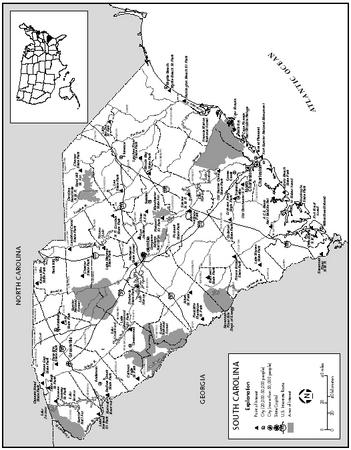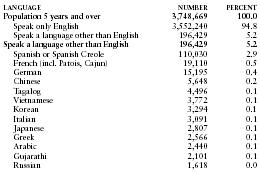South Carolina
Languages
English settlers in the 17th century encountered first the Yamasee Indians and then the Catawba, both having languages of the Hokan-Siouan family. Few Indians remain today, and a bare handful of their place-names persist: Cherokee Falls, Santee, Saluda.
South Carolina English is marked by a division between the South Midland of the upcountry and the plantation Southern of the coastal plain, where dominant Charleston speech has extensive cultural influence even in rural areas. Many upcountry speakers of Scotch-Irish background retain /r/ after a vowel, as in hard, a feature now gaining acceptance among younger speakers in Charleston. At the same time, a longtime distinctive Charleston feature, a centering glide after a long vowel, so that date and eight sound like /day-uht/ and /ay-uht/, is losing ground among younger speakers. Along the coast and on the Sea Islands, some blacks still use the Gullah dialect, based on a Creole mixture of pre-Revolutionary English and African speech. The dialect is rapidly dying in South Carolina, though its influence on local pronunciations persists.

In 2000, 94.8% of all state residents five years of age and older reported speaking English at home, up from 96.5% in 1990.
The following table gives selected statistics from the 2000 census for language spoken at home by persons five years old and over.

| LANGUAGE | NUMBER | PERCENT |
| Population 5 years and over | 3,748,669 | 100.0 |
| Speak only English | 3,552,240 | 94.8 |
| Speak a language other than English | 196,429 | 5.2 |
| Speak a language other than English | 196,429 | 5.2 |
| Spanish or Spanish Creole | 110,030 | 2.9 |
| French (incl. Patois, Cajun) | 19,110 | 0.5 |
| German | 15,195 | 0.4 |
| Chinese | 5,648 | 0.2 |
| Tagalog | 4,496 | 0.1 |
| Vietnamese | 3,772 | 0.1 |
| Korean | 3,294 | 0.1 |
| Italian | 3,091 | 0.1 |
| Japanese | 2,807 | 0.1 |
| Greek | 2,566 | 0.1 |
| Arabic | 2,440 | 0.1 |
| Gujarathi | 2,101 | 0.1 |
| Russian | 1,618 | 0.0 |